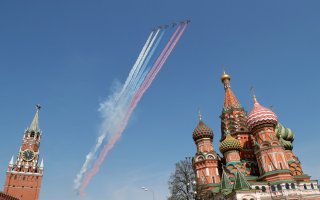NATO Doomed? The Baltic States Can't Fight off the Russian Air Force
The Baltic States don’t have much in the way of air forces.
Key Point: A thin shield is all that stands between the Baltics and Russian airpower.
The air defenses of the Baltic States are too weak to stop Russia or to protect NATO reinforcements coming to their aid, according to a report by an Estonian defense think tank.
Estonia, Latvia and Lithuania are small, and so are their armed forces. The few NATO troops and aircraft stationed there are mere speed bumps, so should Russia invade, succor for the Baltics would have to come from NATO reinforcements.
“Land, air and sea movements, however, are vulnerable to the substantial air power Russia has built in the Western Military District and to its long-range Anti-Access/Area Denial capabilities,” says the International Center for Defense and Security back in 2018. “Air defense is the biggest military capability gap in the region, and while the three states have taken steps to address this, the full range of systems required for comprehensive, layered air defense is prohibitively expensive. This is a concern for the Baltic states, but a vulnerable north-eastern flank should also be a concern for NATO as a whole.”
Russia has about twenty-seven combat air squadrons in its Western Military District which borders the Baltic States, plus additional aircraft based in adjacent regions that could boost Russian air strength in the Baltic region to several hundred aircraft.
To stop them, the Baltic States have a miscellany of European and American surface-to-air missiles and air defense radars, including Swedish RBS-70 and U.S. Stinger short-range anti-aircraft missiles. Lithuania is buying Norwegian medium-range NASAMS missiles, while Estonia still fields old Soviet-era ZU-23-2 anti-aircraft guns. The Baltic states do belong to the NATO-wide NATINAMDS air defense command network and they have set up their own Baltic Air Surveillance Network.
Because the Baltic States don’t have much in the way of air forces, and no jet fighters, NATO provides the Baltic Air Policing initiative, which bases four to eight fighters on Baltic airfields.
Nonetheless, that’s a pretty thin shield against Russian airpower. “The air defense capabilities of the three Baltic states are acutely lacking,” the study concludes with remarkable understatement.
In particular, researchers pointed to lack of medium- and long-range anti-aircraft missiles, insufficient stockpiles of missiles, lack of integration of missiles with battle command systems, gaps in low-level radar coverage and interoperability issues between BALTNET and NATO systems. Interestingly, the study notes a lack of connectivity between the Baltic States and Swedish and Finnish air operations centers, indicating the importance of neutral—but increasingly NATO-leading—Sweden and Finland to any relief of the Baltic nations against invasion.
The Estonian study recommends the Baltic States acquire medium-range anti-aircraft systems and an adequate supply of missiles, as well as better command and communications networks. But the more controversial recommendations involve NATO. The study recommends that the alliance should beef up its command networks to the point that the Baltic Air Policing mission should become an actual air defense mission. NATO military commanders should also be authorized to activate a joint air headquarters in times of crisis, without waiting for political approval.
While these recommendations are practical, the salient fact is that Russia is big and the Baltic States are little, too weak to really defend themselves against Russian invasion without Western intervention. On the other hand, stronger air defenses would make any Russian attack more expensive, which might exert some deterrent effect. That’s as much as the Baltic States can hope for.
Michael Peck is a contributing writer for the National Interest. He can be found on Twitter and Facebook.
This article first appeared in 2018.
Image: Reuters

